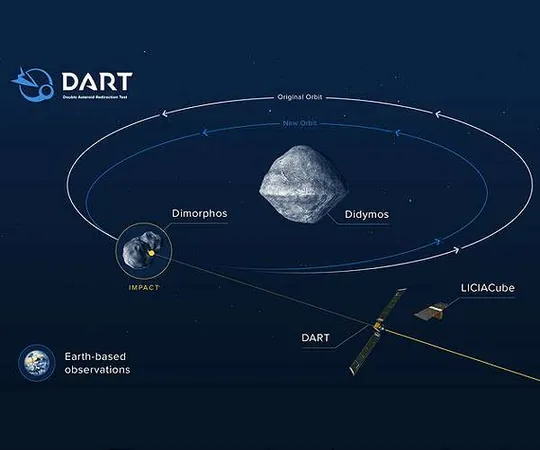
Astronomers Discover Earth-Crossing Asteroid from Shocking Source!
2025-04-14
Author: Daniel
A Surprising Discovery on the Cosmic Frontier
In an astonishing revelation, astronomers at the W. M. Keck Observatory in Hawai'i have unearthed the origins of a newly discovered Earth-crossing asteroid, known as 2024 YR4. Unbelievably, this stony giant hails from a region in the Main Belt between Mars and Jupiter—a locale previously thought unsuitable for such space rocks.
The Unusual Characteristics of YR4
The asteroid, which was located in December 2024, spins every 20 minutes in a retrograde motion and boasts an irregular, flattened shape. According to lead researcher Bryce Bolin, this solid rock-like body provides significant clues to its formation and structural integrity, which are vital for assessing any potential threat it may pose. "Understanding these attributes is crucial as it determines the methods we would need to use should it ever be on a collision course with Earth," Bolin stated.
Impact Risks and Scientific Opportunities
Although initial predictions sparked fears of a potential impact with Earth in 2032, further investigations have all but eliminated that worry. However, scientists still estimate a 2% chance that YR4 could collide with the Moon. "With its diameter of about 50-60 meters, about the size of a football field, it ranks among the largest space objects that could potentially hit the Moon," Bolin explained. "Such an event would provide an exceptional opportunity for scientists to observe the relationship between asteroid size and the dimensions of the crater it would create—a feature we have not been able to analyze up until now."
Understanding Asteroid Composition
Most asteroids larger than 100 meters tend to be 'rubble piles'—loose aggregates formed from debris after massive collisions. YR4, on the other hand, appears to be a remnant from such a larger body, potentially comprising solid rock rather than loose material. This characteristic distinguishes it from many other larger asteroids which often exhibit varied thermal behavior due to their surface composition.
Precision Observation Techniques
To gather extensive data about YR4, Bolin's team employed Keck's Multi-Object Spectrograph for Infrared Exploration (MOSFIRE), achieving impressive precision in their measurements. Collaborations with the Asteroid Terrestrial-impact Last Alert System (ATLAS) and the Gemini South telescope in Chile further refined their findings.
The Importance of Rapid Characterization
In a stroke of luck, the team redirected their focus from trans-Neptunian objects to YR4, leading to invaluable insights. The swift and accurate characterization of potentially hazardous asteroids like YR4 is now considered crucial for planning mitigation strategies in case of a future threat.
As Bolin summarizes, "Our research will pave the way for developing rapid response techniques for assessing the properties of asteroids and determining the best course of action in the unlikely event of an impact threat." This discovery not only showcases the unpredictable nature of space exploration but also enhances our understanding of the cosmos!


 Brasil (PT)
Brasil (PT)
 Canada (EN)
Canada (EN)
 Chile (ES)
Chile (ES)
 Česko (CS)
Česko (CS)
 대한민국 (KO)
대한민국 (KO)
 España (ES)
España (ES)
 France (FR)
France (FR)
 Hong Kong (EN)
Hong Kong (EN)
 Italia (IT)
Italia (IT)
 日本 (JA)
日本 (JA)
 Magyarország (HU)
Magyarország (HU)
 Norge (NO)
Norge (NO)
 Polska (PL)
Polska (PL)
 Schweiz (DE)
Schweiz (DE)
 Singapore (EN)
Singapore (EN)
 Sverige (SV)
Sverige (SV)
 Suomi (FI)
Suomi (FI)
 Türkiye (TR)
Türkiye (TR)
 الإمارات العربية المتحدة (AR)
الإمارات العربية المتحدة (AR)